Recording matches in order to transcribe and analyze them with eXtreme Gammon or other software is widely recognized as one of the most effective ways to improve your game. The pieces of the puzzle are (1) camera, (2) stand, (3) head screw, (4) power source, (5) file storage, and (6) match transcription. The set-up pictured here (belonging to Albert Steg) has become very popular on the ABT circuit. Depending on the components you choose, you can get yourself set up for $175 – $250.

Camera - YI 4K Action Camera
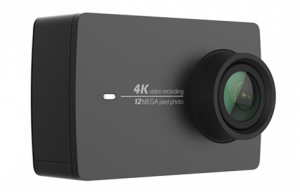 The first thing to recognize is that recording backgammon matches is a relatively simple and non-demanding task, so you don’t need to buy “too much camera.” Small, inexpensive, easy to use, the YI 4K Action Camera has emerged as the favorite on the BG scene. The camera is supported by a “YI Action” smartphone app that enables you to adjust the framing and settings, The app can be a little buggy and difficult to set up depending on your phone but you can do without it, simply hitting the play button and eyeballing the small screen on the camera back to make sure you’re getting the whole board in frame. Here are some pointers on setting up your YI camera for backgammon.
The first thing to recognize is that recording backgammon matches is a relatively simple and non-demanding task, so you don’t need to buy “too much camera.” Small, inexpensive, easy to use, the YI 4K Action Camera has emerged as the favorite on the BG scene. The camera is supported by a “YI Action” smartphone app that enables you to adjust the framing and settings, The app can be a little buggy and difficult to set up depending on your phone but you can do without it, simply hitting the play button and eyeballing the small screen on the camera back to make sure you’re getting the whole board in frame. Here are some pointers on setting up your YI camera for backgammon.
Memory Card – You’ll want to get a Micro-SD memory card to store your videos in the camera. A 128GB card can store over ten hours of video, but you can go bigger or smaller as you like. You’ll want to have a spare or two to swap out if you need more storage before transferring files to your computer, or in case one dies on you.
Resolution – 1080 at 24fps works well. You don’t need super hi-res for backgammon.
Video Quality – Low
Field of View – Medium. You can experiment to get the framing you want for your backgammon set-up.
Adjust Lens Distortion – On. This option corrects the “fishbowl effect.”
File Size – Here you have a choice. If you choose Max, the video will be recorded continuously in a single file, but will automatically shut down when the file size reaches 30GB. Depending on your settings, this could be around the 3-hour mark, so you may risk losing the end of a very long match if you get engrossed and forget to re-start the camera to begin a fresh file at some point. The other option is 4GB, which means the camera, though running continuously as long as it has power, will begin a new file when the current one reaches 4GB, so your matches will be chopped up into multiple files that are a bit more work to manage — but you can stitch them together with a video editor of course.
Those are the essential settings — there are others you can experiment with as you like.
Of course, there are plenty of other cameras out there that can serve this purpose.
Stand - custom design by Máté Fehér
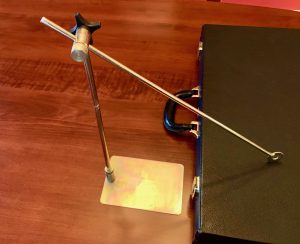 Máté Fehér, a Hungarian player who produces backgammon videos and assists with match-streaming in tournaments all over the world, saw the need for a simple, efficient camera stand for recording backgammon sessions and answered it with this terrific little number. While many solutions require tripods or clamps that only work on the ends of tables, this stand slips under the edge of your backgammon board itself, while the adjustable rods allow you to place the camera at whatever angle and altitude you need. The stand comes in three easy-to assemble pieces — two rods and the flat base, making for easy packing and rapid deployment to any spot in the tournament room. Simple, unobtrusive, effective.
Máté Fehér, a Hungarian player who produces backgammon videos and assists with match-streaming in tournaments all over the world, saw the need for a simple, efficient camera stand for recording backgammon sessions and answered it with this terrific little number. While many solutions require tripods or clamps that only work on the ends of tables, this stand slips under the edge of your backgammon board itself, while the adjustable rods allow you to place the camera at whatever angle and altitude you need. The stand comes in three easy-to assemble pieces — two rods and the flat base, making for easy packing and rapid deployment to any spot in the tournament room. Simple, unobtrusive, effective.
The Gamonator Recording Stand - *NEW*
 Seasoned tournament director and BMAB organizer extraordinaire Ben Friesen has developed a bold new recording stand that ticks all the boxes. Sturdy, attractive, compact, and most importantly, fantastically adjustable. Starting from the simple screw-down base, you just guide each segment where you want it and tighten down its wing nut. Each of the four segments rotates in all directions, so you don’t have to worry so much where along the board you tuck in the base. The camera screws directly into the built-in mount, so there’s no need to keep track of a loose screw in your kit bag. The entire thing folds up and fits into a little 5″ x 8″ profile for super-easy storage in your luggage or even your backgammon board with proper padding. All this for $90 in person, or $100 including shipping within the domestic USA.
Seasoned tournament director and BMAB organizer extraordinaire Ben Friesen has developed a bold new recording stand that ticks all the boxes. Sturdy, attractive, compact, and most importantly, fantastically adjustable. Starting from the simple screw-down base, you just guide each segment where you want it and tighten down its wing nut. Each of the four segments rotates in all directions, so you don’t have to worry so much where along the board you tuck in the base. The camera screws directly into the built-in mount, so there’s no need to keep track of a loose screw in your kit bag. The entire thing folds up and fits into a little 5″ x 8″ profile for super-easy storage in your luggage or even your backgammon board with proper padding. All this for $90 in person, or $100 including shipping within the domestic USA.
Ben & Roberto can also deliver an entire recording setup that will provide everything you need (Gamonator stand, Yi camera, memory card, power bank charger). Prices vary based on exact components selected.
You can purchase the Gamonator Recording Stand directly from Ben Friesen. or Roberto Litzenberger.
Tripod Screw / Mini Ball Head
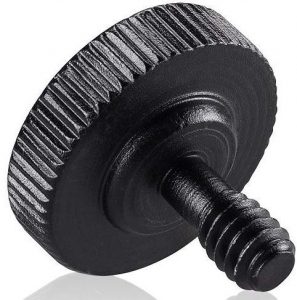 One niggling detail you need to attend to is a 1/4″ tripod screw (at right) that will affix your camera to the eyelet at the end of the cross-rod of the camera stand — you probably won’t get one included with either the camera or the stand! The YI 4K camera has a standard screw-mount at the base of the unit, so basically you just need a bolt-like widget, or, well, a $.25 bolt to engage the camera’s 1/4″ thread and affix it snugly to the stand arm.
One niggling detail you need to attend to is a 1/4″ tripod screw (at right) that will affix your camera to the eyelet at the end of the cross-rod of the camera stand — you probably won’t get one included with either the camera or the stand! The YI 4K camera has a standard screw-mount at the base of the unit, so basically you just need a bolt-like widget, or, well, a $.25 bolt to engage the camera’s 1/4″ thread and affix it snugly to the stand arm. 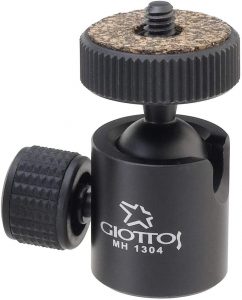 This shouldn’t be a big deal, but you want to be careful that the bolting device you use is a comfortable fit with the stand-arm, which means it can’t have too big a collar that will bump into the ridge where the eyelet is welded to the arm.
This shouldn’t be a big deal, but you want to be careful that the bolting device you use is a comfortable fit with the stand-arm, which means it can’t have too big a collar that will bump into the ridge where the eyelet is welded to the arm.
Though not required, many players like to use a “mini ball-head” camera mount (at left) for easier adjustment of the camera pitch and angle. At $22 on Amazon, this Giottos-brand mini ball head does the trick as well as any other, but there are several brands out there to choose from, so it might be worth hunting around for a better bargain.
Power Source - Portable Chargers
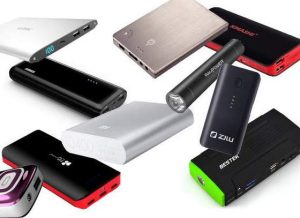 The lithium battery in your camera will typically last only 2-3 hours, and you certainly don’t want to tether yourself to a wall outlet — so a portable battery charger is a must. It’s a good idea to get one capable of charging two devices at once: your camera and your phone — particularly if you use your phone for streaming music while you play. It’s also smart to get a charger that will power your devices for a full day without recharging: 15,000 milliamps (mAh) should do it, while some are happier with 20,000 mAh, which is likely to get you through a whole weekend. Here’s a helpful overview of factors you might consider in buying a charger.
The lithium battery in your camera will typically last only 2-3 hours, and you certainly don’t want to tether yourself to a wall outlet — so a portable battery charger is a must. It’s a good idea to get one capable of charging two devices at once: your camera and your phone — particularly if you use your phone for streaming music while you play. It’s also smart to get a charger that will power your devices for a full day without recharging: 15,000 milliamps (mAh) should do it, while some are happier with 20,000 mAh, which is likely to get you through a whole weekend. Here’s a helpful overview of factors you might consider in buying a charger.
File Storage - Cards & Drives
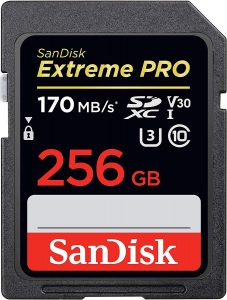 As mentioned in the notes on the camera, you should have an ample amount of storage space available to you on SD memory cards for capturing the video footage in real time as you play your matches. Your next task is to move these files from the memory cards onto the computer you will eventually use to perform the match analysis using a backgammon program like eXtreme Gammon (XG). If you are going home after your session, it’s just a matter of plugging your camera into your computer and copying over the video files. If you are on the road, you might bring along a laptop computer, perhaps with its own external hard drive, where you can copy over the files at bedtime, checking to see they’ve been properly duplicated by morning. Another strategy is to move them from your memory cards over to a cloud storage service like DropBox or GoogleDocs. If you don’t want to bother with any of this on the road, you can use multiple memory cards to hold all your files until you get home – perhaps dedicating one SD card per day for the sake of clarity, even if you don’t fill any of them.
As mentioned in the notes on the camera, you should have an ample amount of storage space available to you on SD memory cards for capturing the video footage in real time as you play your matches. Your next task is to move these files from the memory cards onto the computer you will eventually use to perform the match analysis using a backgammon program like eXtreme Gammon (XG). If you are going home after your session, it’s just a matter of plugging your camera into your computer and copying over the video files. If you are on the road, you might bring along a laptop computer, perhaps with its own external hard drive, where you can copy over the files at bedtime, checking to see they’ve been properly duplicated by morning. Another strategy is to move them from your memory cards over to a cloud storage service like DropBox or GoogleDocs. If you don’t want to bother with any of this on the road, you can use multiple memory cards to hold all your files until you get home – perhaps dedicating one SD card per day for the sake of clarity, even if you don’t fill any of them.
If your video files are very important to you it is a good practice to follow a back-up strategy where each file exists in two locations — say, on the original SD card and your laptop hard drive. Or on your laptop hard drive and in the cloud. If you accidentally erase one, or it is somehow corrupted, you will have the other as a fallback.
Good habits for recording matches
You can save yourself some headaches by following some practices during recording that will make it easier to make sense of your files days or weeks later. First, use paper labels to show who is playing on each side of the board. On your opponent’s name slip, also write the event and round #, and invite your opponent to write their email address on the front or back so that you can send them a copy of the match transcription if they would like one. You can also display both strips in the middle of the board at the start of the match as a title card, or make a title card with a separate piece of paper if you tend to get matches confused. At the end of the match, you can re-use your own name tag, and save your opponent’s name slip for future reference. At the end of the weekend, you can match up the slips of paper with your video files so you know which is which.
Do use an easily legible scoreboard so that the transcriber can always tell what point in the match they are viewing.
Match Recording Services
If all of this is a bit much, or if you are uncertain whether you will find match transcription worthwhile, you will find that at most major tournaments nowadays, there will be one or more people offering a paid service for recording matches, managing your video files, and providing the final transcriptions. Sometimes the tournament director will have a few recording stations set up for daily rental. Certain other individuals bring along multiple recording stations and offer personalized services to suit your needs. Ben Friesen, who assists in management of many ABT tournaments, and David Klausa, who directs the Fort Collins Backgammon Club in Colorado are two people who often provide recording/transcription services at the various tournaments they attend.
The BMAB Option
Many tournament directors at ABT tournaments and around the world now include separate BMAB events on the first day of their tournament schedule. At these events, participants play a modified round-robin series for matches that are recorded and transcribed by staff and applied to each players official BMAB rating. Many players may worry that they aren’t eligible for such an event because the strength of the field is often formidable — but players of all skill levels are equally welcome! It’ is a fantastic value, because the entry fees are reasonable and everyone is guaranteed to play the 6 or 7 matches planned for the event! You will also have an opportunity to play against some of the top names in the tournament — a great experience, win or lose. After one BMAB tournament you will have a listed rating, and a clear benchmark for improvement. So don’t be shy!
Match Transcription
Once you have your match videos at hand, the final step is to transcribe the matches, entering dice rolls, plays, and cube actions into your analysis software (probably eXtreme Gammon) and see how you played! You can do this in ‘real time’, with the video playing in one window while you play along in XG, perhaps pausing to study interesting decision points and blunders. However, a skilled transcriber with the proper computer set-up can plow through matches at accelerated speeds of two or three times actual pace by replaying the video at 2x+ speed and keeping up with a numeric keypad and mouse.
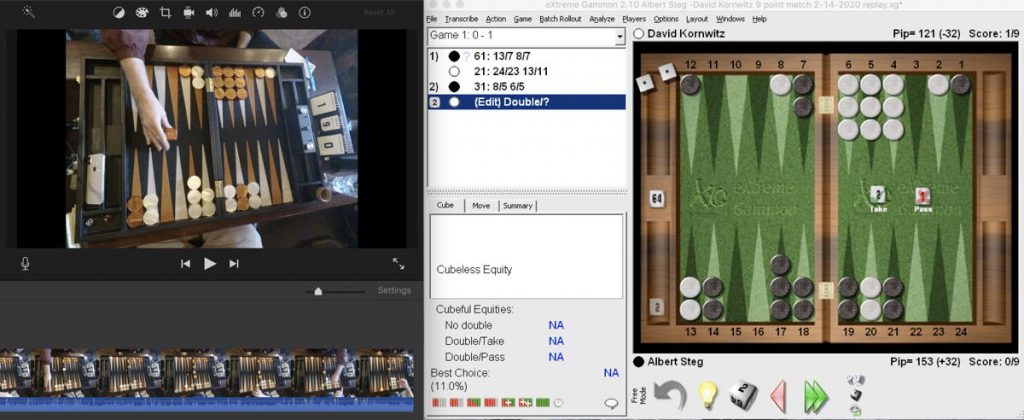
Transcription Services
If you have less time (and patience) than money, you can hire a transcriber who will deliver XG-ready files in short order, so that you can spend your time actually studying your errors and figuring out how to improve your game. People who offer this service charge either a flat fee per match, and then an incremental fee per game, or a flat fee based on match length, so you’re usually looking at something in the $8-$20 range for a single match. (And sometimes your opponent might be willing to chip in half!) Assuming you are recording your own matches, you just need a means of getting the video transcriptions to the transcriber. One way is to upload the files to YouTube and send your transcriber the links. Another is to transfer them via an online file-sharing service like Dropbox or Google Docs. You can even just send your memory cards to a transcriber through snail mail.
A small cottage industry has popped up around this activity, which is especially popular with players who compete frequently and want to get feedback on their play promptly from the road. Currently a quick google search turns up Backgammon Transcription Service, a European outfit that charges by the move, and various Fiverr gigs and Facebook offers that might fit the bill (though NEBC can vouch for none).
You can contact Máté Fehér, David Klausa, and Miriam Brunetti to compare rates on their transcription services.
